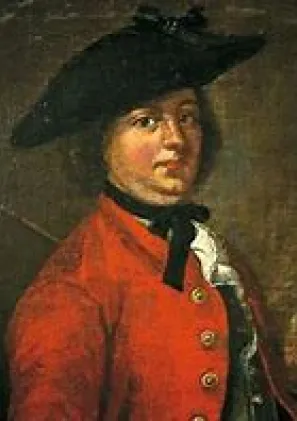Biography
1719 - 1781
Maria van Antwerpen was born in Breda, The Netherlands in 1719. Orphaned at thirteen, van Antwerpen began working as a maidservant and continued to do so until 1746 when she was dismissed for visiting relatives on Christmas. Unemployed and afraid of becoming a prostitute, van Antwerpen changed her identity to Jan van Ant and enlisted in the army as a soldier. Two years later she married Joanna Cramers, the daughter of his sergeant. However, in 1751 she was stationed in her hometown and was recognized by a former employer, reported to authorities, and arrested. van Antwerpen was put on trial for making a mockery of marriage and entering into an illegal marriage. The courtroom hearing caused a sensation. A song and a biography were written about her. As a result of the trial, van Antwerpen was banished from all garrison towns. She moved to Rotterdam and then Gouda, making a living as a seamstress though she continued to wear men’s undergarments. In 1762 van Antwerpen met the unmarried and pregnant Cornelia Swartsenberg. van Antwerpen soon changed gender again and became Machiel van Antwerpen and enlisted in the army once more. The couple moved to Amsterdam, where van Antwerpen worked for the city as a soldier. There Swartsenberg gave birth to a son who was baptized, with van Antwerpen recognized as the father. The infant died after seven weeks. On a trip to Gouda in 1769 van Antwerpen was once again recognized and charged with mocking holy and human laws concerning marriage. At age fifty, van Antwerpen returned to court. The resulting interrogation produced copious pages of text, making van Antwerpen one of the most highly documented working-class persons of the age. When asked to what sex “she” belonged, van Antwerpen famously declared, [I am] “by nature and character, a man, but in appearance, a woman... It often made me wrathful that Mother Nature treated me with so little compassion against my inclinations and the passions of my heart.” van Antwerpen was banished yet again and disappeared from history entirely, aside from the notation that she died in 1781 in her hometown of Breda at the age of 62.
1719 - 1781
Maria van Antwerpen was born in Breda, The Netherlands in 1719. Orphaned at thirteen, van Antwerpen began working as a maidservant and continued to do so until 1746 when she was dismissed for visiting relatives on Christmas. Unemployed and afraid of becoming a prostitute, van Antwerpen changed her identity to Jan van Ant and enlisted in the army as a soldier. Two years later she married Joanna Cramers, the daughter of his sergeant. However, in 1751 she was stationed in her hometown and was recognized by a former employer, reported to authorities, and arrested. van Antwerpen was put on trial for making a mockery of marriage and entering into an illegal marriage. The courtroom hearing caused a sensation. A song and a biography were written about her. As a result of the trial, van Antwerpen was banished from all garrison towns. She moved to Rotterdam and then Gouda, making a living as a seamstress though she continued to wear men’s undergarments. In 1762 van Antwerpen met the unmarried and pregnant Cornelia Swartsenberg. van Antwerpen soon changed gender again and became Machiel van Antwerpen and enlisted in the army once more. The couple moved to Amsterdam, where van Antwerpen worked for the city as a soldier. There Swartsenberg gave birth to a son who was baptized, with van Antwerpen recognized as the father. The infant died after seven weeks. On a trip to Gouda in 1769 van Antwerpen was once again recognized and charged with mocking holy and human laws concerning marriage. At age fifty, van Antwerpen returned to court. The resulting interrogation produced copious pages of text, making van Antwerpen one of the most highly documented working-class persons of the age. When asked to what sex “she” belonged, van Antwerpen famously declared, [I am] “by nature and character, a man, but in appearance, a woman... It often made me wrathful that Mother Nature treated me with so little compassion against my inclinations and the passions of my heart.” van Antwerpen was banished yet again and disappeared from history entirely, aside from the notation that she died in 1781 in her hometown of Breda at the age of 62.
Demography
Demography
Gender Female
Sexual Orientation Lesbian
Gender Identity Genderqueer/Non-Binary
Ethnicity Caucasian/White
Faith Construct Catholic
Nations Affiliated Netherlands
Era/Epoch Baroque (1600-1750) Enlightenment (1685-1815) Industrial Revolution (1760-1840)
Field(s) of Contribution
Military
World History
Demography
Gender Female
Sexual Orientation Lesbian
Gender Identity Genderqueer/Non-Binary
Ethnicity Caucasian/White
Faith Construct Catholic
Nations Affiliated Netherlands
Era/Epoch Baroque (1600-1750) Enlightenment (1685-1815) Industrial Revolution (1760-1840)
Field(s) of Contribution
Military
World History
